Overview
This article delves into the diverse methods and strategies for securing financing to acquire an existing business in Australia. It underscores the critical importance of understanding various financing options and eligibility criteria. Prospective buyers are encouraged to explore:
- Traditional bank loans
- Vendor support
- Private equity
- Alternative lending avenues
Furthermore, it emphasizes the necessity of thorough preparation and relationship-building with lenders to significantly enhance the chances of successful financing. By grasping these concepts, readers can better navigate their financial landscape and make informed decisions.
Introduction
Navigating the intricate world of business acquisition financing in Australia can indeed be a daunting task for prospective buyers. With a myriad of options—from traditional bank loans to innovative private equity investments—understanding this landscape is crucial for making informed decisions. As the financial environment continues to evolve, particularly in 2025, key factors such as market conditions and the financial health of target businesses play a pivotal role in shaping financing opportunities.
This article delves into the various financing methods available, eligibility criteria for securing loans, and essential steps to prepare a compelling business plan. By empowering buyers with this knowledge, we aim to help them successfully navigate their financing journey.
Whether leveraging seller financing or engaging with mortgage brokers, the insights provided here will equip potential business owners with the tools needed to thrive in a competitive marketplace.
Understanding Business Acquisition Financing in Australia
Acquisition funding in Australia encompasses a variety of approaches designed to provide the necessary finance for purchasing an existing business. These methods include traditional bank loans, private equity investments, seller support, and alternative lending options. Each path presents distinct benefits and factors that prospective purchasers must understand to make informed decisions.
In 2025, the landscape of acquiring enterprises is shaped by several critical elements. The financial health of the target business is paramount, as creditors typically evaluate profitability, cash flow, and existing liabilities. Moreover, prevailing market conditions can significantly influence the availability and terms of funding.
For example, recent statistics reveal that lenders are increasingly willing to extend credit, evidenced by Prospa's increase in its line of credit limit from $150,000 to $500,000, reflecting a more favorable lending environment.
Current trends indicate a growing preference for flexible funding solutions, as buyers seek options that cater to their specific needs. Seller assistance, where the seller provides a loan to the buyer, has gained momentum, facilitating smoother transactions and potentially lower upfront costs. Additionally, private equity firms are actively exploring investment opportunities in established companies, presenting another avenue for funding.
Understanding these funding methods is essential for potential buyers aiming to finance the acquisition of an existing business in Australia. Familiarity with the nuances of each option can prepare you for the subsequent steps in the funding process, including negotiations and securing optimal terms. For instance, when evaluating a freehold property venture, buyers may encounter scenarios where the commercial property is valued at $1 million, with an enterprise price of $400,000, culminating in a total asking price of $1.4 million.
In such cases, lenders typically allow borrowing against the commercial property at a maximum loan-to-value ratio (LVR) of 70%, translating to a potential loan of $700,000, which necessitates a deposit of $300,000 and an additional $400,000 for the operational segment. Case studies illustrate effective funding strategies, such as PMA's commitment to clear communication and a straightforward lending process, enhancing client satisfaction and confidence in the lending journey. Expert insights underscore the importance of thorough due diligence and strategic planning when seeking finance to purchase an existing business in Australia.
Engaging with knowledgeable advisors can provide valuable insights into the most suitable funding options tailored to your unique circumstances. As the funding landscape continues to evolve in 2025, staying informed about current trends and statistics will empower you to navigate the complexities of securing capital for your acquisition. Furthermore, with Finance Story's expertise in managing challenging financial situations and its dedication to personalized service, potential buyers can feel assured in their financial journey.
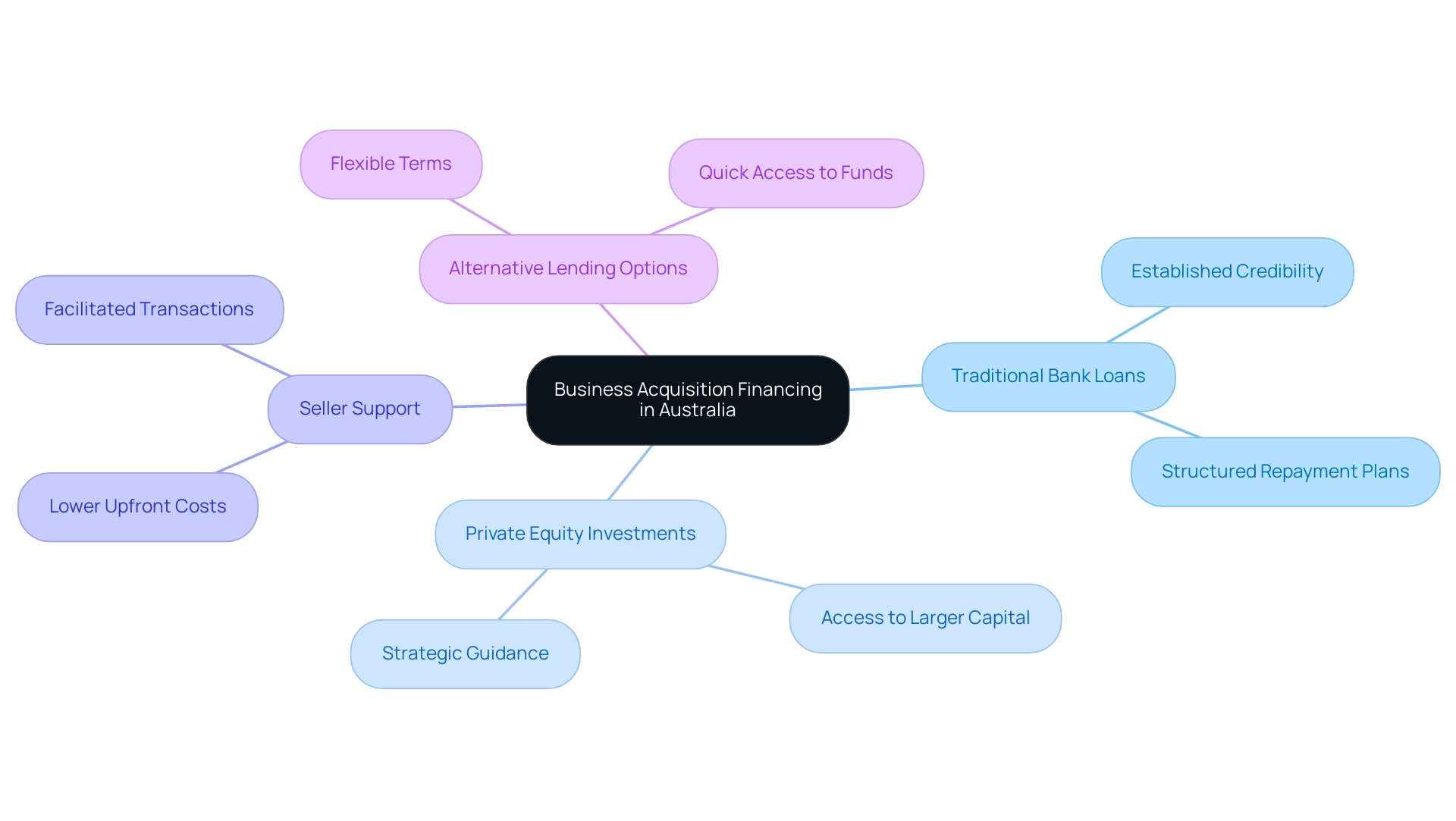
Exploring Financing Options for Business Purchases
When exploring financing options for purchasing a business, buyers have several avenues to consider:
- Bank Financing: Traditional bank financing remains a popular choice due to its competitive interest rates. However, obtaining finance to purchase an existing business in Australia typically necessitates extensive documentation and a robust credit history. In 2025, the average loan amount requested for commercial purchases hovers around $94,845, reflecting a cautious optimism among small and medium enterprises (SMEs) eager to leverage loans for growth. Additionally, the average monthly balance per commercial credit card account stands at $15,166, indicating a significant financial resource available for operational expenses. For those contemplating a freehold property venture, lenders often allow borrowing against the commercial property, usually with a maximum loan-to-value ratio (LVR) of 70%. Consequently, for a commercial property valued at $1M, a buyer could secure a loan of $700k, necessitating a deposit of $300k, along with additional funds for the business portion of the purchase.
- Vendor Support: This arrangement allows the seller to provide funding directly to the buyer, offering more flexible payment terms. Vendor financing has gained traction in Australia, with success stories underscoring its effectiveness in facilitating smoother transactions. Financial advisors frequently recommend this option for its potential to alleviate cash flow pressures during the process of financing the purchase of an existing business in Australia. As Shaun McGowan, Founder of Money.com.au, emphasizes, "It's crucial for individuals and companies to pay as little as possible for financial products, through education and building world-class technology."
- Private Equity: For larger acquisitions, private equity investors may inject capital in exchange for ownership in the enterprise. This option can be advantageous as it not only provides necessary funds but also strategic guidance from seasoned investors.
- Alternative Lending: Online lenders and peer-to-peer platforms have emerged as viable options for quick access to funds, albeit often at higher interest rates. These options can be particularly beneficial for purchasers requiring prompt funding to secure a commercial opportunity.
Furthermore, when considering equity utilization, buyers should assess their available equity in existing properties. For instance, if a buyer owns a residential property valued at $1.3M, they could potentially access up to $740k in equity, which could be directed towards the purchase of a freehold property, alongside the necessary deposit and additional costs such as valuation and legal fees.
Additionally, Indigenous Business Australia expanded its loan offerings in February 2023 to support economic development in Indigenous communities with low-interest loans, showcasing the evolving landscape of funding options available to diverse communities.
By evaluating these options, purchasers can make informed choices regarding financing the purchase of an existing business in Australia that align with their financial capabilities and objectives. Consulting with financial advisors is strongly recommended, particularly when contemplating vendor funding or alternative lending, to ensure that the selected path promotes long-term success.
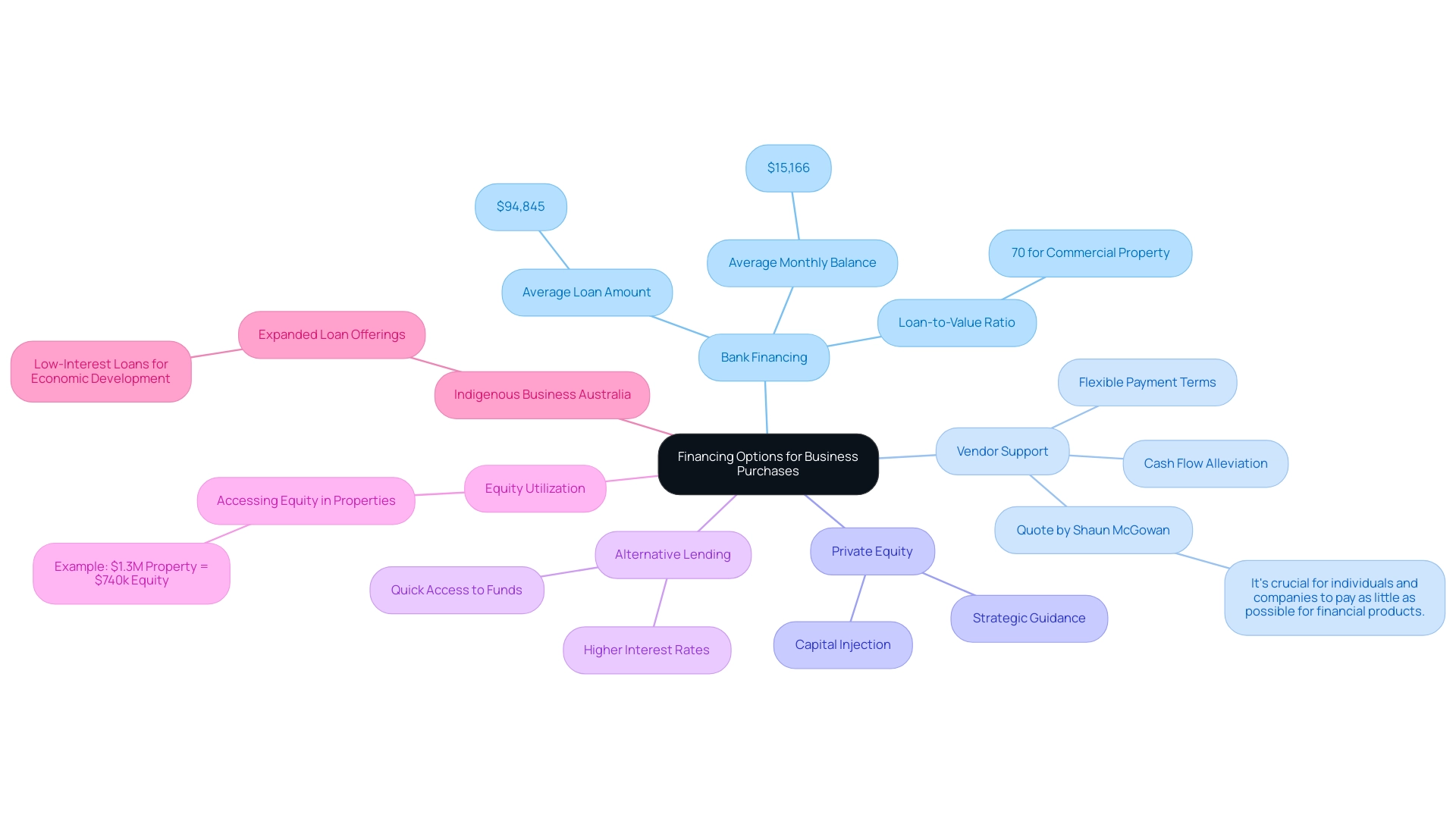
Eligibility Criteria for Securing Business Financing
Obtaining finance to purchase an existing business in Australia requires buyers to navigate several key eligibility criteria, essential for lenders when evaluating credit applications. These criteria include:
- Credit Score: A robust credit score is paramount, reflecting the buyer's repayment capability. In 2025, the average credit score for loans in Australia serves as a crucial benchmark that potential borrowers should aim to exceed to improve their chances of approval.
- Strategy Outline: A meticulously crafted strategy outline is often a prerequisite. This document should detail the viability of the acquisition and project the financial performance of the enterprise post-purchase, demonstrating to lenders that the investment is sound. Financial advisors emphasize that a well-organized strategy is not merely a formality but a foundation for obtaining funding, highlighting the significance of preparation in the financing process.
- Financial Statements: Lenders typically require both personal and business financial statements. These documents provide insight into the buyer's financial condition and stability, enabling creditors to make informed choices regarding the application.
- Some financial institutions may necessitate collateral to secure the loan. This could involve assets from the company being acquired or personal assets, serving as a safety net for the lender in case of default.
- Experience: Demonstrating relevant industry experience can significantly bolster a buyer's credibility. Lenders are more inclined to approve financing for individuals who possess a solid understanding of the market landscape, as this reduces perceived risk.
In 2025, as 78% of founders express intentions to expand their enterprises globally, understanding these eligibility criteria becomes increasingly vital. Phil Collard, a lending expert at Money.com.au, notes, "This is still being approached with caution, but SMEs are increasingly looking to scale up their operations by leveraging loans to help fuel growth." By aligning with these criteria, buyers can enhance their prospects for successful applications for finance to purchase an existing business in Australia, paving the way for their enterprise acquisition endeavors.
Finance Story's dedication to establishing robust, enduring connections with clients ensures they feel comprehended and assisted throughout the finance to purchase an existing business in Australia process. The brokerage focuses on developing refined and highly customized proposals to present to banks, ensuring that clients have access to tailored funding options that effectively navigate these eligibility criteria. With a diverse portfolio of private lenders and mainstream financial institutions, including options for warehouses, retail premises, factories, and hospitality ventures, Finance Story distinguishes itself in the market, offering innovative lending solutions that address the unique needs of small enterprises.
As one satisfied client stated, "Finance Story made the financing process seamless and tailored to our needs, allowing us to focus on expanding our enterprise.
Step-by-Step Process to Apply for a Business Loan
Securing finance to purchase an existing business in Australia requires a systematic approach that can significantly enhance your chances of approval. Here’s a step-by-step guide to effectively navigate the application process:
- Assess Your Needs: Begin by determining the exact amount of funding required and the specific purposes for which it will be utilized. This clarity will guide your discussions with potential financiers.
- Research Lenders: Conduct thorough research to identify a range of lenders, including the complete suite available through Finance Story. Compare their offerings, focusing on interest rates, loan terms, and any unique features they may provide. This step is vital, as Anna Bligh, CEO of the Australian Bankers' Association, emphasizes, "These small enterprises will propel Australia through the crisis, and after it has subsided, employ millions of Australians as the economy recovers." Making an informed choice of financing source is crucial in this context.
- Prepare Documentation: Compile all necessary documentation, including financial statements, tax returns, and a comprehensive business plan. Having these documents ready will streamline the application process and demonstrate your preparedness to financial institutions.
- Submit Application: Complete the loan application form meticulously, ensuring all information is accurate and aligns with your documentation. Submit this along with your prepared documents to the selected financial institution.
- Follow Up: Maintain open lines of communication with the financial institution. Regular follow-ups can help address any questions they may have and demonstrate your commitment to the process.
- Review Financing Terms: Upon receiving approval, take the time to carefully examine the financing terms. Ensure they align with your financial goals and that you fully understand the implications before signing.
In 2025, the average duration to obtain financing in Australia is roughly 4 to 6 weeks, depending on the lender and the complexity of your application. Additionally, construction finance options are available up to $5 million, with terms that may include prepaid or capitalized interest, often without stringent serviceability tests. Loan terms for construction finance typically range from 3 to 36 months.
This flexibility can be particularly beneficial for companies aiming to finance the purchase of an existing business in Australia or to expand their operations.
By following these steps and leveraging the diverse financing options available, including the innovative solutions offered by Finance Story, you can secure finance to purchase an existing business in Australia and position yourself for a successful loan application. Our expertise in creating polished and individualized proposals ensures that you have the right support for your commercial property investments. Additionally, we provide a comprehensive selection of lenders to suit your circumstances, including refinancing options to meet the evolving needs of your enterprise.
Schedule your free personalized consultation with Finance Story's Head of Funding Solutions, Shane Duffy, to discuss your needs and goals, paving the way for your acquisition or expansion objectives.
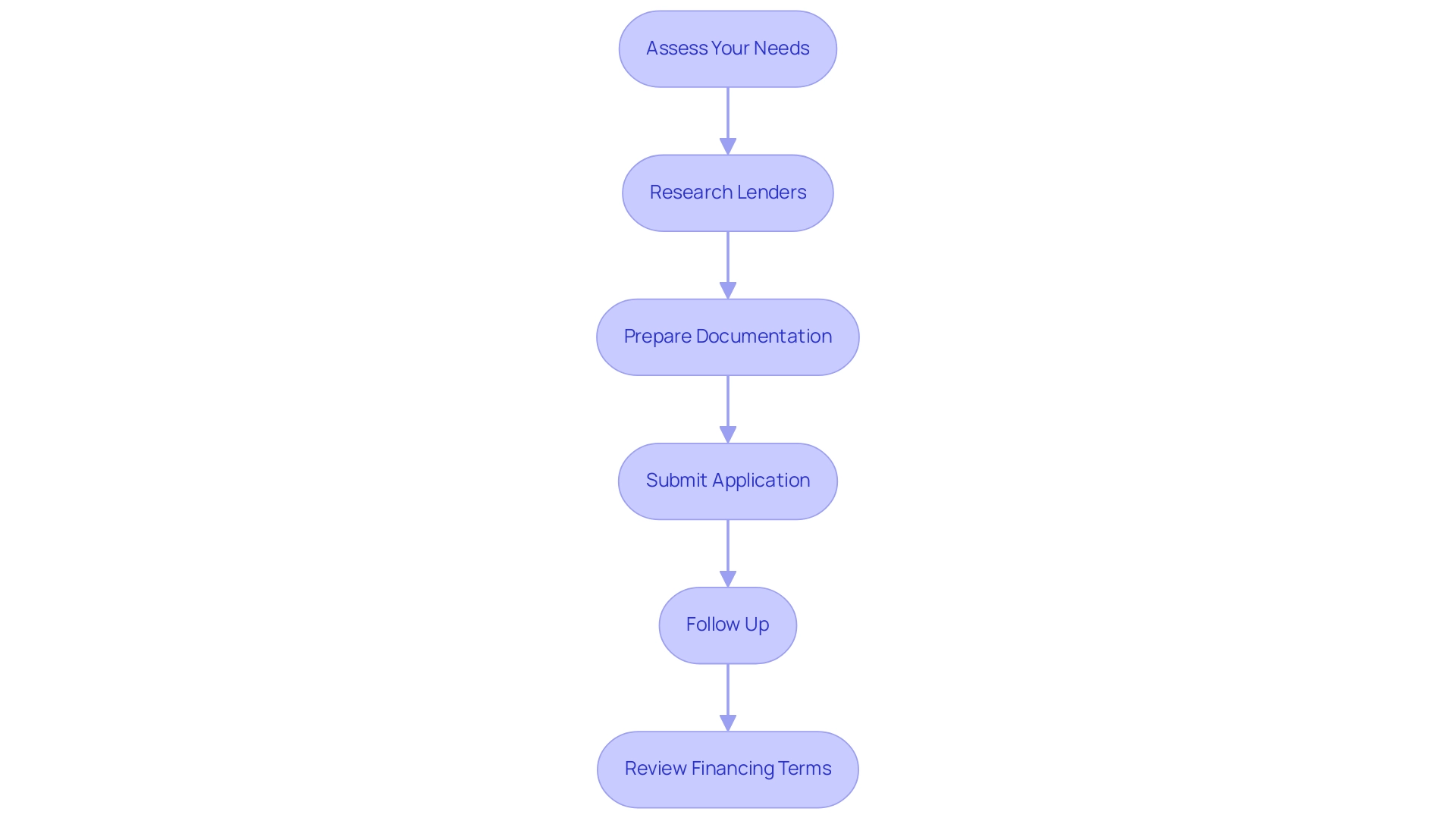
Preparing Your Business Plan and Financial Documents
A robust enterprise plan and comprehensive financial documents are crucial for obtaining the necessary finance to purchase an existing business in Australia. Here’s a detailed guide on how to prepare these essential components:
-
Executive Summary: Begin with a concise overview of your concept, articulating the purpose of the acquisition and the anticipated outcomes. This section should capture the essence of your vision and set the tone for the rest of the plan.
-
Market Analysis: Conduct a thorough analysis of the industry landscape, including insights into your target market and competitive dynamics. Grasping the current market conditions is essential, particularly given that over 41% of enterprises have encountered supply chain disruptions since early 2022, which can influence your acquisition strategy. Additionally, with an exit rate of 14.0%, totaling 362,893 exits, it’s essential to recognize the challenges that companies face in this environment.
-
Financial Projections: Present detailed financial forecasts, including cash flow statements, profit and loss projections, and break-even analysis. Accurate financial projections are paramount; analysts emphasize that they significantly enhance the credibility of your loan application for finance to purchase an existing business in Australia. In 2025, the precision of financial forecasts will be more essential than ever, as creditors aim to reduce risks related to funding.
-
Funding Requirements: Clearly specify the amount of funding you require and provide a breakdown of how these funds will be utilized. This transparency assists financiers in comprehending your financial requirements and the possible return on their investment related to finance to purchase an existing business in Australia. For instance, if you are considering a freehold property venture with a commercial property price of $1M and a valuation including stock of $400k, understanding the loan-to-value ratio (LVR) is essential. Usually, lenders permit a maximum LVR of 70% for commercial properties, indicating you would need to provide a deposit of $300k and extra funds for the operational part of the purchase, totaling $700k.
-
Supporting Documents: Attach relevant financial documents, such as tax returns, bank statements, and any other pertinent records that can substantiate your financial position. The importance of these documents cannot be overstated; they serve as evidence of your financial health and bolster your case for securing a loan. As Raja Abbas observed, small enterprises constitute 97.2% of all firms in Australia, emphasizing their importance in the economy and the need for robust financial documentation.
In creating your plan, consider successful examples from other ventures that have successfully navigated the funding landscape. For instance, recent trends indicate that while total new capital expenditure in Australia saw a slight decline of 0.2% in December 2024, projections for 2025-26 suggest a recovery with an estimated increase of 1.8%. This context can provide valuable insights into the current investment climate and help you position your plan accordingly.
Moreover, think about utilizing resources such as Finance Story, which focuses on customized loan proposals and refinancing alternatives, advocating digital-first adaptable tools as possible finance tech collaborators for startups aiming to expand.
By carefully developing each part of your plan and confirming the precision of your financial documents, you will improve your opportunities of obtaining the necessary finance to purchase an existing business in Australia.
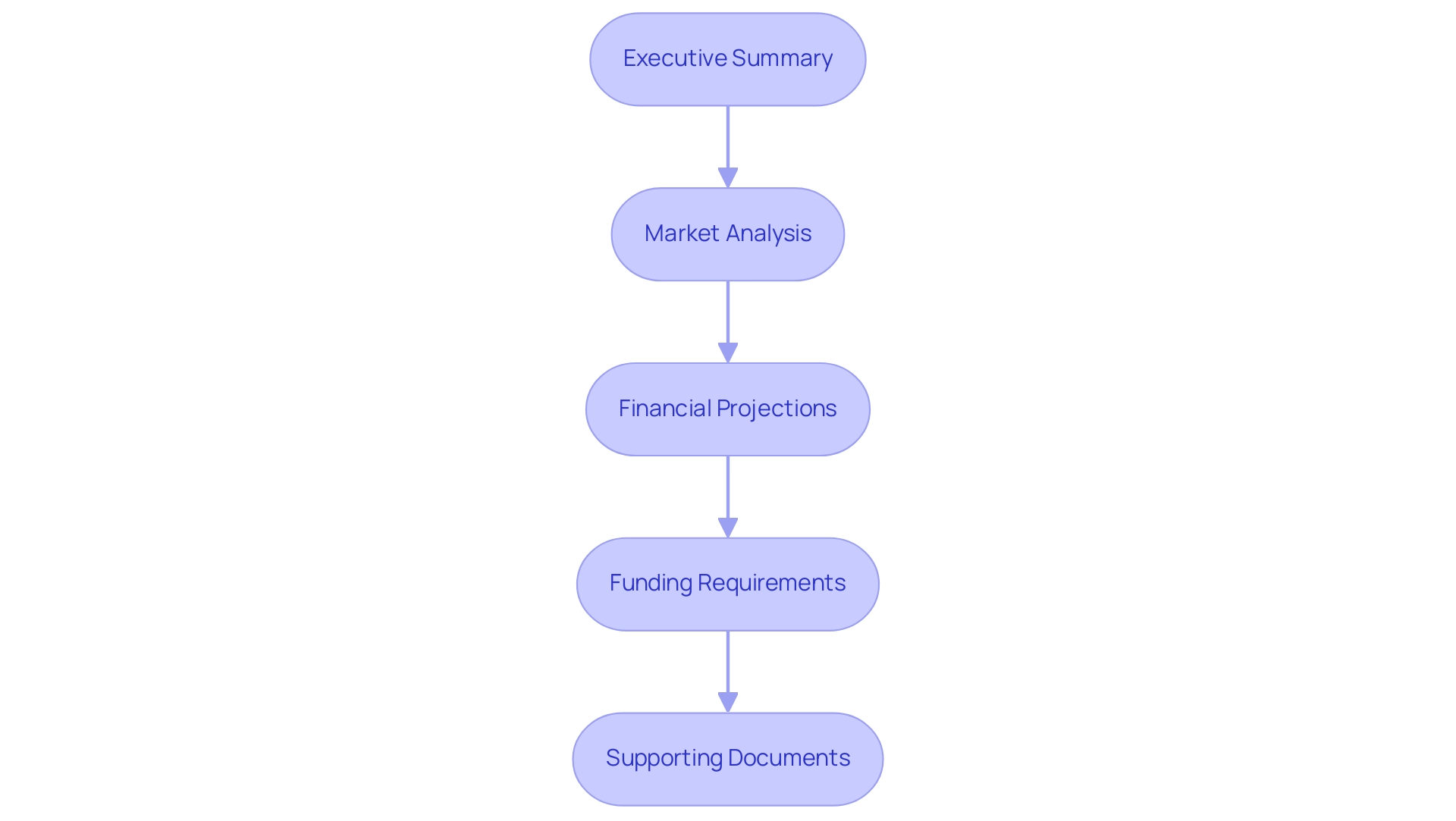
The Role of Mortgage Brokers in Business Financing
Mortgage brokers play a pivotal role in the financing landscape, providing a suite of services that greatly benefit clients seeking to finance the purchase of an existing business in Australia. Their contributions can be summarized as follows:
- Accessing Multiple Financial Institutions: Brokers cultivate relationships with a diverse array of creditors, enabling them to pinpoint the most competitive rates and terms tailored to their clients' specific needs. This access is particularly advantageous in a recovering economy, where the demand for commercial financing is on the rise, generating a wealth of options for borrowers. As Finance Story emphasizes, "We have a comprehensive panel of lenders across mainstream banks, private lenders, and angel investors, ensuring we cover every aspect of your funding needs."
- Streamlining the Process: The application process for commercial loans can often feel overwhelming. Mortgage brokers simplify this journey by guiding clients through the necessary documentation and requirements, ensuring that every detail is handled efficiently. This streamlined approach not only saves time but also alleviates the stress associated with securing financing. Finance Story specializes in crafting polished and highly individualized business cases to present to banks, significantly enhancing the likelihood of approval.
- Negotiating Terms: One of the standout advantages of collaborating with a broker is their ability to negotiate financing terms on behalf of their clients. Leveraging their industry expertise and connections, brokers can frequently secure more favorable terms, resulting in substantial savings over the course of the financing. Finance Story's proficiency in understanding loan repayment criteria ensures that clients are well-informed about their funding options.
- Providing Expertise: With a profound understanding of the lending landscape, mortgage brokers offer invaluable expertise that empowers buyers to make informed decisions regarding their funding options. Their insights into market trends and lender requirements equip clients to navigate the complexities of financing effectively. Finance Story's commitment to comprehending organizational needs through comprehensive lending solutions positions it as a trusted ally in this journey.
- Refinancing Options: Beyond facilitating new loans, mortgage brokers also aid clients in refinancing existing loans to better align with their evolving requirements. This service is crucial for enterprises aiming to optimize their financial strategies and enhance cash flow.
The significance of mortgage brokers in financial financing is underscored by the burgeoning Mortgage Brokers industry in Australia, which has been expanding at a compound annual growth rate (CAGR) of 6.6% from 2019 to 2024. This growth reflects the increasing reliance on brokers as companies strive to capitalize on favorable lending conditions.
Moreover, case studies highlight the success of mortgage brokers in facilitating financial acquisitions. For instance, a recent client of Finance Story remarked, "We are finished with the constant worry. Once again, thank you so much for being a part of our journey," showcasing the positive impact of their services.
As the economy improves, brokers are strategically positioned to leverage the rising demand for commercial lending, allowing them to diversify their offerings and cater to a broader client base. This trend not only benefits brokers but also enhances loan approval rates for clients, making the funding process more accessible. The expansion of commercial lending presents a lucrative avenue for mortgage brokers, enabling them to better serve clients in a recovering economy.
In summary, the knowledge and resources that mortgage brokers provide are essential for small enterprises seeking to finance the purchase of an existing business in Australia. Their ability to access multiple lenders, streamline processes, negotiate favorable terms, and offer expert guidance makes them an indispensable partner in the journey toward ownership. Finance Story's dedication to professionalism and a profound understanding of the finance sector further positions it as a trusted ally in navigating these financial challenges.
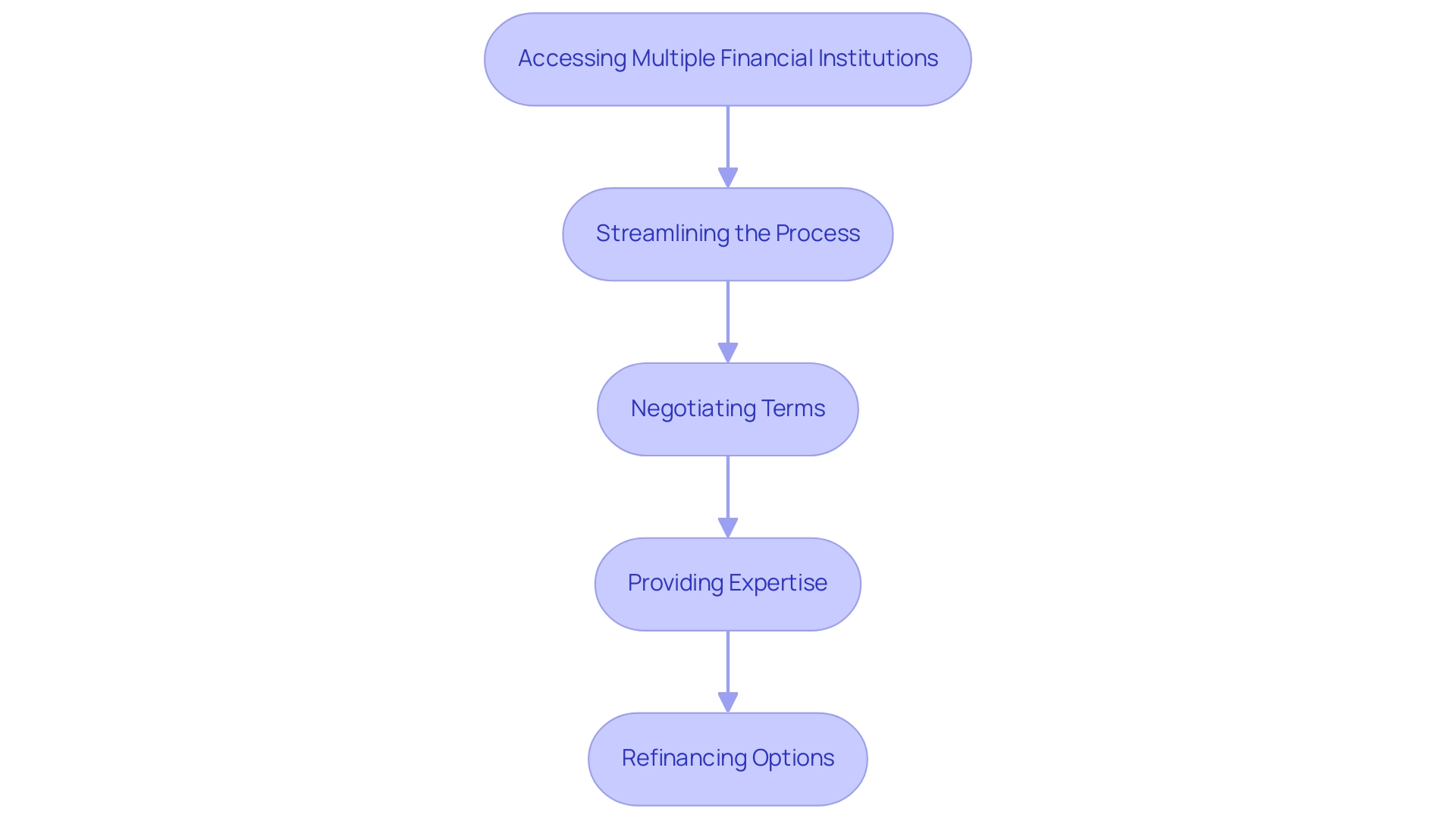
Overcoming Challenges in Securing Business Financing
Navigating the landscape of obtaining capital in Australia can present numerous obstacles that require careful navigation. Here are some key challenges and strategies to consider:
-
Insufficient Documentation: One of the most prevalent hurdles is the lack of complete and accurate documentation. To prevent delays in the approval process, ensure that all required documents—such as financial statements, tax returns, and business plans—are meticulously prepared and organized.
-
Poor Credit History: A poor credit history can significantly restrict your financing options. It is crucial to proactively work on improving your credit score before seeking financial assistance. This may involve paying down existing debts, ensuring timely payments, and correcting any inaccuracies on your credit report. A robust credit score not only enhances your chances of approval but can also yield more favorable financing terms. As noted by Isabelle Comber, a business finance writer, "Improving your credit history is essential for accessing better financing options and terms."
-
High Debt-to-Income Ratio: Lenders often scrutinize your debt-to-income ratio when evaluating your loan application. If your existing debts are excessively high relative to your income, it may raise red flags for potential lenders. To improve your chances of securing funding, consider strategies to reduce your current debt levels, thereby presenting a healthier financial profile.
-
Market Conditions: The economic landscape can significantly influence lending practices. Factors such as fluctuating interest rates and overall market stability can affect your ability to obtain funding. Staying informed about these conditions allows you to adapt your strategy effectively, whether that means timing your application or adjusting your financial requests.
Understanding these challenges is essential, particularly in 2025, when the exit rate for enterprises stands at 14.0%, with 362,893 departures recorded. This statistic underscores the importance of strategic planning in securing funds, as companies increasingly aim to utilize resources for growth within a careful borrowing environment. The typical financing amount requested by small enterprises is $94,845, primarily intended for funding commercial vehicles and daily capital, emphasizing the necessity for businesses to pursue funding with a clear objective and strategy.
For those considering a freehold property venture, it is vital to understand the financing structures involved. Typically, lenders permit borrowing against commercial property, often with a maximum loan-to-value ratio (LVR) of 70%. For instance, if the commercial property is valued at $1M, you could secure a loan of $700k, necessitating a deposit of $300k.
Furthermore, if you are acquiring an enterprise valued at $400k, you would need to provide a total of $700k, factoring in additional costs such as legal fees and valuations.
On the other hand, if you are contemplating leasehold enterprises, funding options may be limited to cash savings or equity from properties you own. For example, if your residence is appraised at $1.3M with $300k owed, you could access up to $740k in equity, which could be combined with cash savings to finance your acquisition.
By confronting these challenges directly and applying effective strategies for enhancing your credit history, you can improve your chances of obtaining the necessary finance to purchase an existing business in Australia. Finance Story, with its reputation for professionalism and deep understanding of the finance sector, is well-equipped to assist you in navigating these challenges and securing the best loan solutions tailored to your needs.
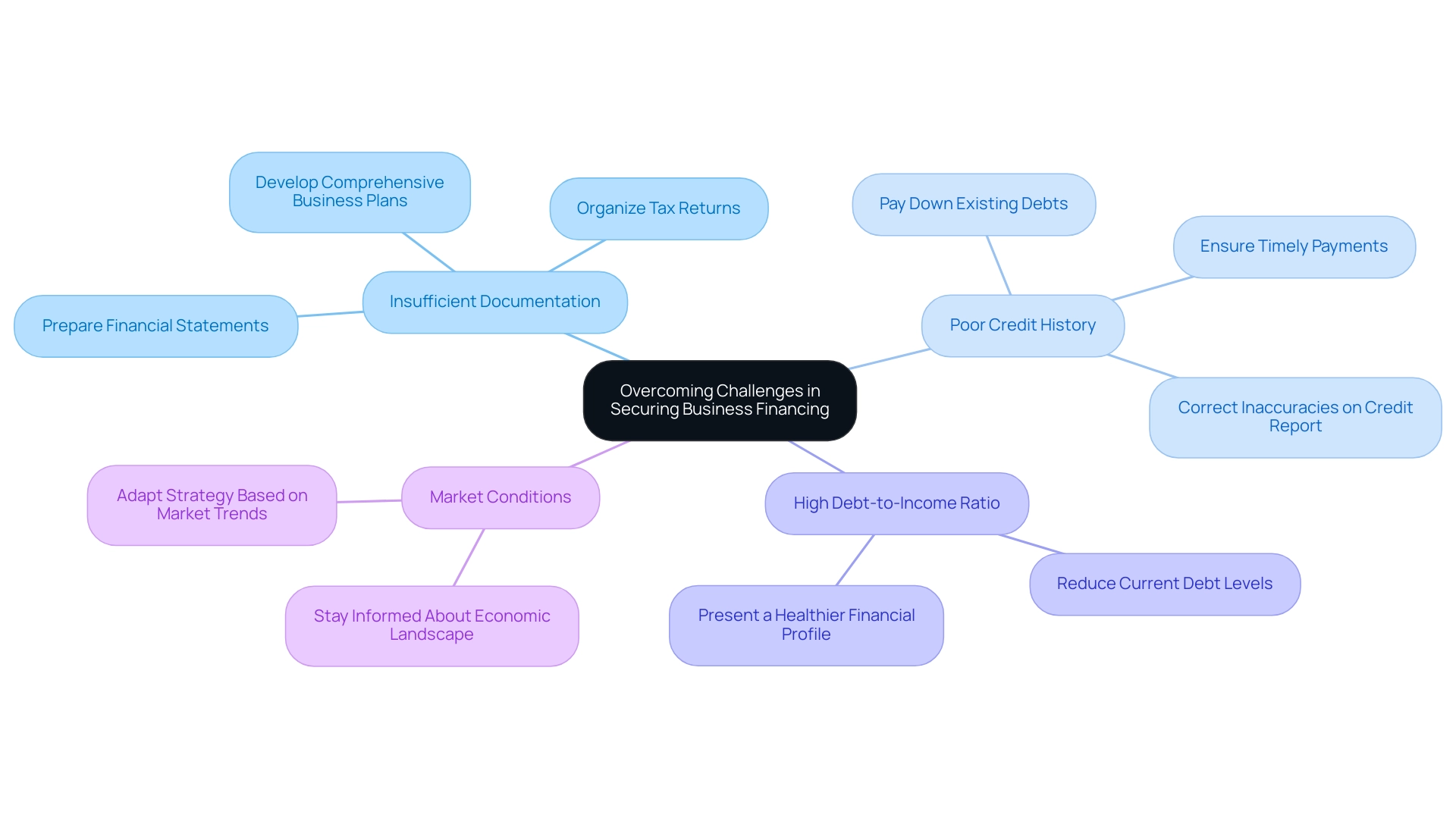
Building Relationships with Lenders for Future Success
Building strong connections with creditors is essential for attaining lasting success in financing. Consider implementing several effective strategies:
- Regular Communication: Maintain consistent contact with your financial institution by providing updates on your company's performance and any changes in your financial situation. This proactive approach not only keeps your financial institution informed but also demonstrates your commitment to transparency.
- Transparency: Being open about your business needs and challenges fosters trust and understanding. Financial advisors emphasize that this clarity can lead to more advantageous credit terms and conditions, as financiers value clients who are forthright about their situations.
- Demonstrating Reliability: Timely repayments and adherence to loan agreements are crucial for building a positive reputation with your financial institution. A strong track record of reliability enhances your credibility and facilitates the acquisition of future funding.
- Networking: Actively participate in industry events and engage with financial institutions to strengthen your professional connections. Effective networking can yield improved funding opportunities, as creditors are more inclined to consider clients they know and trust.
- Understanding the Impact of Communication: Effective communication can significantly influence borrowing terms. Research indicates that companies maintaining open channels of communication with their financiers often secure more favorable funding terms, showcasing the financier's trust in the borrower's openness and dependability. Notably, the value of new personal fixed-term loan commitments for 'Other' increased by 25.9% from December Quarter 2023 to December Quarter 2024, reflecting a positive lending environment for small business owners.
- Expert Insights: Financial advisors stress the importance of cultivating relationships with financial institutions, noting that a strong rapport can provide better support during challenging times. This relationship can be particularly beneficial when navigating complex financial circumstances, as creditors are more willing to collaborate with trusted clients. For instance, Finance Story focuses on developing refined and customized cases to present to banks, ensuring clients secure appropriate funding solutions tailored to their needs. Additionally, Finance Story offers a comprehensive array of providers, including high street banks and creative private lending panels, to address diverse funding requirements.
- Case Studies: Numerous companies have successfully leveraged strong lender relationships to secure financing during critical growth phases. For example, Finance Story has distinguished itself through its commitment to innovation and adaptability in the lending process, effectively navigating challenging financial situations for its clients. These examples underscore the tangible benefits of investing time and effort into building and maintaining these connections. As one satisfied client remarked, "Finance Story was instrumental in helping us secure the funding we needed during a crucial time in our growth."
As Ms. Pannek pointed out, "This report provides clear evidence of a thriving industry that delivers real value to consumers and increasingly so for entrepreneurs." By implementing these strategies, business owners can enhance their chances of securing favorable financing options and achieving their financial goals in 2025 and beyond.
Conclusion
Navigating the landscape of business acquisition financing in Australia is a complex yet vital endeavor for prospective buyers. This article has explored a variety of financing options, including traditional bank loans, vendor financing, private equity, and alternative lending solutions. Each option presents its own set of advantages and challenges, underscoring the importance of understanding the unique requirements of each method.
The eligibility criteria for securing business financing are equally critical. A strong credit score, a well-crafted business plan, and thorough financial documentation are essential components that potential buyers must prepare. With the right approach and preparation, buyers can significantly enhance their chances of obtaining the necessary funding to realize their business acquisition goals.
Furthermore, the step-by-step process outlined for applying for a business loan highlights the importance of research, documentation, and communication. Engaging with mortgage brokers can further streamline this process, providing access to multiple lenders and expert negotiation on behalf of buyers. Building solid relationships with lenders is paramount for long-term success, as trust and transparency can lead to more favorable financing terms in the future.
In conclusion, the evolving financing landscape in Australia presents both opportunities and challenges for aspiring business owners. By staying informed about current trends, understanding eligibility criteria, and leveraging the expertise of mortgage brokers, buyers can navigate this intricate financial environment with confidence. With the right preparation and support, securing financing for business acquisitions can pave the way for growth and success in a competitive marketplace.



